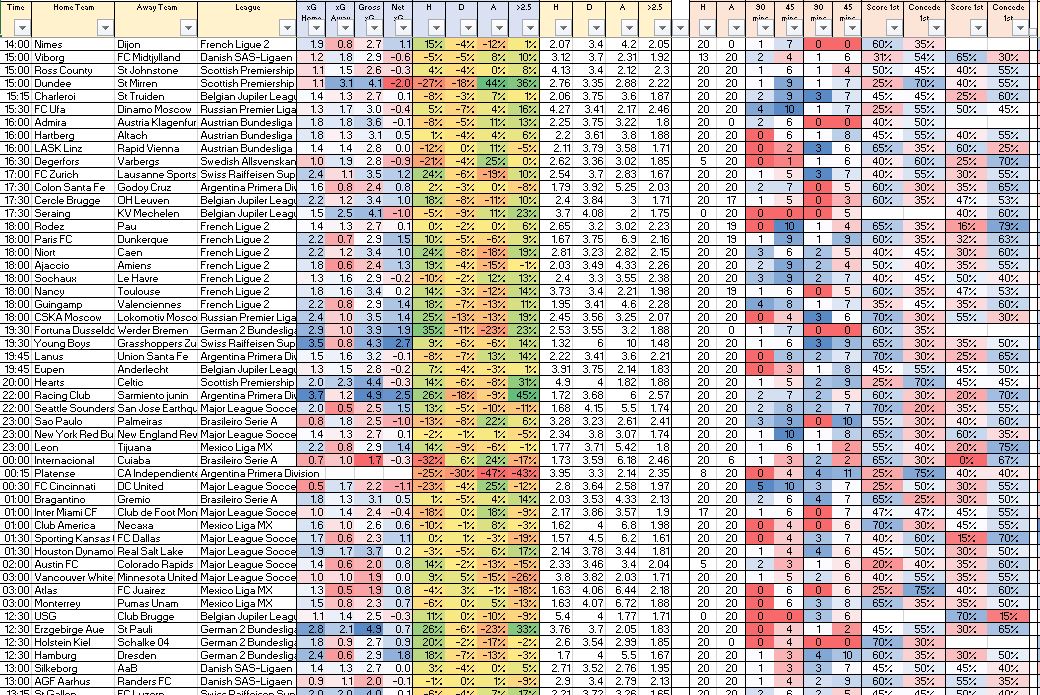xG Predictions and Trading – Tips and Strategies
Profitable football trading is not easy due to the football markets being very efficient. This means the chance of a team actually winning (or scoring x goals) is often very closely related to the odds. Accepting the odds being offered by the market/bookmaker without assessing whether they are providing value, will make you an unprofitable trader in the long-term.
Most professional sports traders will tell you the best way for long-term profitable football trading is to either:
- Pre-game: Make value bets (measured by consistently beating the closing price i.e. obtain better odds than the final odds at kick-off time).
- In-Play: Watch the games and get in and out the market when a goal looks likely to be scored. Again, in-play bets should only be placed where the odds are offering value.
Football xG provides great resources to help with your football trading:
- An Excel summary of all upcoming matches (it includes the predicted xG, % chances for each result outcome based on an adjusted Poission model, games where there appears value in the odds, and historical statistic averages across 2,5, and 10 games). This is an invaluable tool to help make better football trading decisions.
- This tool can then be used to help with both pre-game and in-play trades (see below):
Pre Game
- Use the xG Predict spreadsheets (uploaded twice weekly) to identify games which are showing value.
- Perform further research into team news, injuries, current market direction.
- If the value appears genuine, open a trade.
- Remember, you will only be profitable long term if you are obtaining odds higher than the closing-line (odds at kick-off). Closing-line odds are when the markets are at their most efficient.
- Pro-tip: avoid placing bets at kick-off time as all the value in the market will have usually gone.
In-Play
- Use the spreadsheet (uploaded twice weekly on the blog) to identify games which are expecting high amounts of goals or low amounts.
- Watch the game and when the game looks lively (lots of attacking pressure and shots) open a trade on the goal markets. The in-play tool (provided as part of the xG Pro subscription) provides a great resource for assessing whether the in-play odds are offering value.
- Conversely, if we are not expecting goals and the game in not lively, this can be a good opportunity to back the unders markets.
- If a goal does go in, the xG Pro spreadsheets provides stats on how a team usually performs when going ahead or behind. Decisions can then be made on whether to close the trade or leave it open. Odds dependent, it could even be valuable to reverse the trade.
- Pro-tip: in-play betting is no different to pre-game betting, in that you always need to obtain value. e.g. it may look like a goal is coming in the 90th minute but if the odds being offered are not providing value, then the opposite trade is often the best trade.
Check out the various spreadsheets and tools that Footballxg provide to help take your trading to the next level.
Please also see our general trading advice below.
xG Beginner Football Trading Strategies
Below are strategies to use for trading the football markets where goals are expected. Further guidance is given below:
1) Select and watch a game (and/or use sofascore.com) which we expect to have goals. When the game starts to show a period of sustained pressure, we enter the market (how to enter the market varies by strategy). If there is no sustained pressure (i.e. doesn’t look like a goal is coming) we don’t open the trade.
Maintaining your bank is key, so only open a trade when a goal looks like it is coming and only ever bet a small percentage of your betting bank. See the section on the right (desktop users) for some specific strategies to consider.
2) Once the trade is opened, there are multiple ways to play it (See sections below). Before we get to that, it is critical to keep hammering home the importance of value.
No Value = No bet
Pro-tip: always consider if there is value in the trade. The easiest way to do this is to think in percentages rather than odds. For example, if the odds of a goal in the last 20 minutes are 1.8:
- Convert this to a percentage (1/1.8 = 56%)
- Based on the current game state and historical stats of late goals for the given teams, ask yourself this question: “if the game was played 100 times with these exact circumstance, how often do you believe there will be a goal?“.
- If the answer is greater than 57 out of 100 (i.e. 57% or greater), then the odds are providing value.
Identifying true odds/percentages is arguably the most challenging part of in-play football trading (in simple terms, if you continually obtain odds better than the true chance of it happening, then you will be profitable in the long run).
If you have no idea on how to assess whether there is value, we do offer an in-play odds calculator which is included with all xG Pro subscriptions.
Football Trading – Simple Method
- Let the trade run. If it wins it wins, if it loses it loses.
Football Trading – Simplish Method
- A goal is scored in our favour: odds should drop and then we either:
- (1) close the trade if the sustained pressure drops,
- (2) keep the trade open if a second goal looks likely (as soon as a second goal does not look likely, close the trade).
- No goals:
- if the sustained pressure drops, close the trade for a loss (if before half time (excluding strategy B), the loss should not be too big especially if it’s fairly short priced). To limit losses, exiting prior to 60 minutes is recommended.
- For strategy 1 and 2 only; other team scores first against the run-of play: I’ll emphasize this should be against the run-of play, because if the other team started to dominate then we should have closed the trade.
- If our team continues to pressure, leave the trade open and only close when they are in front.
- If the game dynamics have changed (i.e. our team does not look like they will come back into it), then close the trade for a loss (the earlier this is in the match, the smaller the loss will be). The max loss will be 1pt.
Football Trading – Advanced Method
- See how the game progresses and close out the position if the sustained pressure drops. If the pressure comes back, then reopen the trade (small losses will occur so reopen the trade for the initial stake less any losses).
- If a goal goes in our favour, there is potential to keep open the position if we expect the team to continue pushing for a second (see simplish method). The odds will continue to drop during this period, further increasing the profit. Alternatively, partially close out the position or put all the profits on the team we expect to win for a no loss situation.
- For strategies 1 and 2, if the other teams scores first against the run of play, and our team is showing sustained pressure then potentially open/reopen the trade (this will depend on two factors: (i) our team: how good the winning stats are after conceding the first goal, (ii) opposition team: how good their winning stats are after scoring the first goal). If we open a new position at this stage, the odds will be significantly higher but this will be reflected in the lower strike rate.
Hopefully this page has provided some initial insights on how to approach football trading. Please check out our xG based prediction models to help take your trading to the next level.
We are also happy to answer any questions you may have. Please use the contact page or contact us via twitter.
Football Trading Strategy 1 – Back Home Team
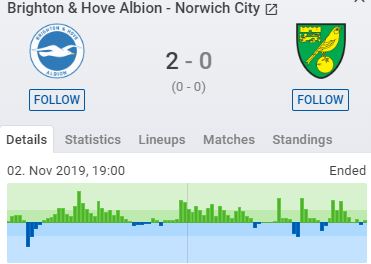
In this strategy we expect the home team to win.
- When the home odds are offering value we enter the trade pre-match (back the Home team). Once the game starts, if there is sustained pressure (see example above with strong green bars) we stay in the trade and the odds should actually drop (contradicting time decay). If the home team is not dominating the trade, we exit the trade for minimal loss. We then keep an eye on the game and look for opportunity to enter again when the home team is starting to dominate.
- If the odds are not showing value, wait for an opportunity later in the game before entering the trade.
Football Trading Strategy 2 – Back Away Team
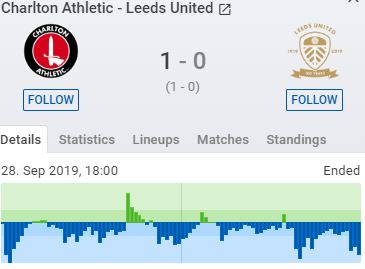
This is the same as strategy A1, except we expect the away team to win.
- If the away odds are offering value we enter the trade pre-match (back the Away team). Once started, if there is sustained pressure (see example above with strong green bars) we stay in the trade and the odds should actually drop (contradicting time decay). If the away team is not dominating the trade, we exit the trade for minimal loss. We then keep an eye on the game and look for opportunity to enter again when the away team is starting to dominate. As you may have noticed in the example above, even though the away team dominated they ended up losing. Always be aware that not every trade will be a winner and be prepared to handle losing runs.
- If the odds are not showing value, wait for an opportunity later in the game before entering the trade.
Football Trading Strategy 3 – 1st Half Goal (max loss 1pt)
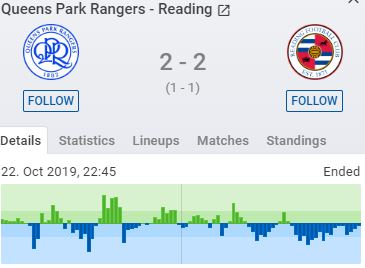
This strategy is where we expect a goal in the first half from either team. Per the example above, we’re expecting to see lots of strong green or blue periods of pressure. One team dominating (e.g. graphs in A1 and A2 are also good).
We need 3 criteria to enter the trade: (i) The games is still 0-0, (ii) the “Lay 1st Half Correct Score” or “under 0.5 goals” odds are less than 3.0 and are showing value, (iii) there are chances being created (either dominating home (per A1), away (perA2), or mixed high bars (per the above). NB: the max loss is 1pt (i.e. if lay at 3.0, hedge out at 1.5 if no goal. If lay at 2.0, the trade can run until Half time).
Football Trading Strategy 4 – 2nd Half Goal (max loss 1pt)
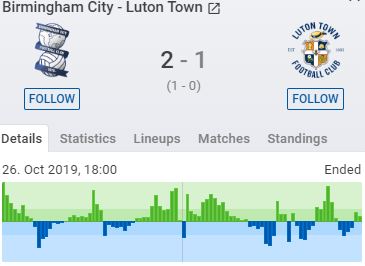
This strategy is where we expect a goal in the second half from either team. Per the example above, we’re expecting to see lots of strong green or blue periods of pressure. One team dominating (e.g. graphs in A1 and A2 are also good).
We need 3 criteria to enter the trade: (i) There has been no goals in the second half, (ii) the ‘Correct Score Lay‘ odds have gone below 4 and are showing value, (iii) there are chances being created (either dominating home (per A1), away (per A2), or mixed high bars (per the above). NB: more liquidity may be present in laying the current unders (e.g. if the HT score is 1-1, lay the Under 2.5 market). Also, the max loss we’re aiming for is 1pt (i.e. if lay at 4.0, take the loss at 2.0. If lay at 3.0, hedge out at 1.5 if no goal. If lay at 2.0, the trade can run until Full-time).
Football Trading Strategy 5 – Back Over 2.5 Goals

This strategy is where we expect goals in the game. Per the example above, we’re expecting to see lots of strong green or blue periods of pressure. One team dominating (e.g. graphs in A1 and A2 are also good).
We need 2 criteria to enter the trade: (i) The ‘Over 2.5‘ odds are showing value, (iii) there are chances being created (see above example and other strategy examples). NB: a drip entry strategy is an option for this trade, along with exiting and entering the market multiple times as goals are scored and/or pressure drops.
Football Trading Strategy 6 – Back Both Teams To Score

This strategy is where we expect both teams to score (BTTS). Per the example above, we’re expecting to see lots of strong green or blue periods of pressure.
We need 3 criteria to enter the trade: (i) The ‘BTTS‘ odds are showing value, (iii) there are chances being created (see above example), (iii) if a goal has been scored, the team that hasn’t scored should be creating chances.
Get started with Football xG. Subscribe to our mailing list and receive updates when new is content added.

